Vibration Characteristics of Carbon Nanotube-Reinforced Sandwich Nanobeams with Hybrid Cellular Core
Abstract
1. Introduction
2. Problem Formulation
3. Numerical Results and Discussion
4. Conclusions
- Influence of Core Geometry and CNT Distribution: The results revealed an inverse relationship between the frequency values of the sandwich nanobeams and the ζ1 values of the hybrid cellular structure core. Specifically, an increase in ζ1 led to a reduction in natural frequencies, particularly affecting the second natural frequencies more significantly. The study also demonstrated that the flexural stiffness of the beam increased with higher carbon nanotube (CNT) volume fractions, with the functionally graded-V (FGV) distribution showing reduced sensitivity to variations compared to the uniformly distributed (UD) CNT configuration.
- Effect of Core Cell Angles: The lowest and highest natural frequencies were observed at core cell angles of −60 degrees with UD 0.28 and 60 degrees with UD 0.12, respectively. The frequency values were more influenced by changes in the core cell angle (θ1) than by variations in the CNT volume fraction. This highlights the importance of core geometry in tailoring the dynamic response of sandwich nanobeams.
- Thickness Ratios and Geometric Properties: The study revealed that beams with different thickness ratios and geometric properties could exhibit identical natural frequencies. This phenomenon was attributed to the balance between bending stiffness and mass distribution, where certain geometric configurations counteracted each other’s effects. Reducing the thickness of the top and bottom layers relative to the core thickness resulted in the lowest and highest frequency values for beams with identical geometric properties.
- Nonlocal Parameter (μ): The nonlocal parameter μ had a significant impact on the natural frequencies, with an increase from 0 to 5 leading to a sharp decrease of approximately 20% in frequency values. This underscores the importance of considering size-dependent effects in the design and analysis of nanoscale structures.
5. Potential Future Work
Author Contributions
Funding
Data Availability Statement
Conflicts of Interest
Appendix A
References
- Coleman, J.N.; Khan, U.; Blau, W.J.; Gun’ko, Y.K. Small but strong: A review of the mechanical properties of carbon nanotube–polymer composites. Carbon 2006, 44, 1624–1652. [Google Scholar] [CrossRef]
- Ma, P.-C.; Siddiqui, N.A.; Marom, G.; Kim, J.-K. Dispersion and functionalization of carbon nanotubes for polymer-based nanocomposites: A review. Compos. Part A Appl. Sci. Manuf. 2010, 41, 1345–1367. [Google Scholar] [CrossRef]
- Maâti, H.; Amadine, O.; Sair, S.; Abouelhrouz, S.; Ouadil, B.; Mahi, H.; Essamlali, Y.; Zahouily, M. Carbon Nanotubes Particles: Processing, Mechanical Properties and Application. In Mechanics of Nanomaterials and Polymer Nanocomposites; Abdellaoui, H., Sanjay, M.R., Siengchin, S., Eds.; Springer Nature: Singapore, 2023; pp. 19–49. [Google Scholar]
- Chwał, M. Free Vibrations and Flutter Analysis of Composite Plates Reinforced with Carbon Nanotubes. Appl. Sci. 2025, 15, 1140. [Google Scholar] [CrossRef]
- Alhakeem, M.R.H. Carbon Nanotube (CNT) Composites and its Application; A Review. Brill. Res. Artif. Intell. 2022, 2, 134–144. [Google Scholar] [CrossRef]
- Pouresmaeeli, S.; Fazelzadeh, S.A. Frequency analysis of doubly curved functionally graded carbon nanotube-reinforced composite panels. Acta Mech. 2016, 227, 2765–2794. [Google Scholar] [CrossRef]
- Lai, Z.; Li, Z.; Lin, B.; Tang, H. Free vibration analysis of rotating sandwich beams with FG-CNTRC face sheets in thermal environments with general boundary conditions. Z. Naturforsch. A 2022, 77, 1153–1173. [Google Scholar] [CrossRef]
- Garg, A.; Chalak, H.D.; Zenkour, A.M.; Belarbi, M.O.; Sahoo, R. Bending and free vibration analysis of symmetric and unsymmetric functionally graded CNT reinforced sandwich beams containing softcore. Thin-Walled Struct. 2022, 170, 108626. [Google Scholar] [CrossRef]
- Belarbi, M.-O.; Salami, S.J.; Garg, A.; Daikh, A.-A.; Houari, M.-S.-A.; Dimitri, R.; Tornabene, F. Mechanical behavior analysis of FG-CNT-reinforced polymer composite beams via a hyperbolic shear deformation theory. Contin. Mech. Thermodyn. 2023, 35, 497–520. [Google Scholar] [CrossRef]
- Masoodi, A.R.; Ghandehari, M.A.; Tornabene, F.; Dimitri, R. Natural Frequency Response of FG-CNT Coupled Curved Beams in Thermal Conditions. Appl. Sci. 2024, 14, 687. [Google Scholar] [CrossRef]
- Rostami, H.; Jedari Salami, S. Large amplitude free vibration of sandwich beams with flexible core and FG Graphene Platelet Reinforced Composite (FG-GPLRC) face sheets based on extended higher-order sandwich panel theory. Thin-Walled Struct. 2022, 180, 109999. [Google Scholar] [CrossRef]
- Talebi, S.; Arvin, H.; Beni, Y.T. Thermal free vibration examination of sandwich piezoelectric agglomerated randomly oriented CNTRC Timoshenko beams regarding pyroelectricity. Eng. Anal. Bound. Elem. 2023, 146, 500–516. [Google Scholar] [CrossRef]
- Kammoun, N.; Feki, N.; Bouaziz, S.; Ben Amar, M.; Soula, M.; Haddar, M. Free Vibration of Sandwich Nanobeam. In Advances in Acoustics and Vibration III; Feki, N., Abbes, M.S., Taktak, M., Amine Ben Souf, M., Chaari, F., Haddar, M., Eds.; Springer International Publishing: Cham, Switzerland, 2021; pp. 277–284. [Google Scholar]
- Shabani, Y.; Khorshidi, K. Buckling Analysis of Sandwich Structures with Metamaterials Core Integrated by Graphene Nanoplatelets Reinforced Polymer Composite. Mech. Adv. Compos. Struct. 2023, 10, 1–10. [Google Scholar] [CrossRef]
- Evans, K.E.; Nkansah, M.A.; Hutchinson, I.J.; Rogers, S.C. Molecular network design. Nature 1991, 353, 124. [Google Scholar] [CrossRef]
- Li, C.; Shen, H.-S.; Yang, J. Nonlinear Vibration Behavior of FG Sandwich Beams with Auxetic Porous Copper Core in Thermal Environments. Int. J. Struct. Stab. Dyn. 2023, 23, 2350144. [Google Scholar] [CrossRef]
- Wen, J.; Wen, X.; Yu, D. Flexural Vibration Band Gaps in Periodic Sandwich Beams with Auxetic Core. In Proceedings of the ASME 2007 International Design Engineering Technical Conferences and Computers and Information in Engineering Conference, Las Vegas, NV, USA, 4–7 September 2007; pp. 471–475. [Google Scholar]
- Zeng, S.; Wang, K.; Wang, B.; Wu, J. Vibration analysis of piezoelectric sandwich nanobeam with flexoelectricity based on nonlocal strain gradient theory. Appl. Math. Mech. 2020, 41, 859–880. [Google Scholar] [CrossRef]
- Herisanu, N.; Marinca, B.; Marinca, V. Longitudinal–Transverse Vibration of a Functionally Graded Nanobeam Subjected to Mechanical Impact and Electromagnetic Actuation. Symmetry 2023, 15, 1376. [Google Scholar] [CrossRef]
- Wang, Q.; Cui, X.; Qin, B.; Liang, Q. Vibration analysis of the functionally graded carbon nanotube reinforced composite shallow shells with arbitrary boundary conditions. Compos. Struct. 2017, 182, 364–379. [Google Scholar] [CrossRef]
- Emdadi, M.; Mohammadimehr, M.; Navi, B. Free vibration of an annular sandwich plate with CNTRC facesheets and FG porous cores using Ritz method. Adv. Nano Res. 2019, 7, 109–123. [Google Scholar] [CrossRef]
- Shabani, Y.; Khorshidi, K. Free vibration analysis of rectangular doubly curved auxetic-core sandwich panels integrated with CNT-reinforced composite layers using Galerkin method. J. Sci. Technol. Compos. 2022, 8, 1677–1686. [Google Scholar] [CrossRef]
- Shen, H.-S. Nonlinear bending of functionally graded carbon nanotube-reinforced composite plates in thermal environments. Compos. Struct. 2009, 91, 9–19. [Google Scholar] [CrossRef]
- Zhu, X.; Zhang, J.; Zhang, W.; Chen, J. Vibration frequencies and energies of an auxetic honeycomb sandwich plate. Mech. Adv. Mater. Struct. 2019, 26, 1951–1957. [Google Scholar] [CrossRef]
- Ntaflos, K.; Beltsios, K.; Hadjigeorgiou, E. A Unified Shear Deformation Theory for Piezoelectric Beams with Geometric Nonlinearities-Analytical Modelling and Bending Analysis. J. Compos. Sci. 2024, 8, 24. [Google Scholar] [CrossRef]
- Aydogdu, M.; Taskin, V.; Aydogdu, M.; Taskin, V. Free vibration analysis of functionally graded beams with simply supported edges. Mater. Des. 2007, 28, 1651–1656. [Google Scholar] [CrossRef]
- Şimşek, M. Fundamental frequency analysis of functionally graded beams by using different higher-order beam theories. Nucl. Eng. Des. 2010, 240, 697–705. [Google Scholar] [CrossRef]
- Khorshidi, K.; Shabani, Y. Free vibration analysis of sandwich plates with magnetorheological smart fluid core by Using modified shear deformation theory. J. Sci. Technol. Compos. 2022, 8, 1826–1835. [Google Scholar] [CrossRef]
- Karama, M.; Afaq, K.S.; Mistou, S. Mechanical behaviour of laminated composite beam by the new multi-layered laminated composite structures model with transverse shear stress continuity. Int. J. Solids Struct. 2003, 40, 1525–1546. [Google Scholar] [CrossRef]
- Karami, B.; Janghorban, M.; Shahsavari, D.; Dimitri, R.; Tornabene, F. Nonlocal Buckling Analysis of Composite Curved Beams Reinforced with Functionally Graded Carbon Nanotubes. Molecules 2019, 24, 2750. [Google Scholar] [CrossRef]
- Li, C.; Zhang, N.; Li, S.; Yao, L.Q.; Yan, J.W. Analytical Solutions for Bending of Nanoscaled Bars Based on Eringen’s Nonlocal Differential Law. J. Nanomater. 2019, 2019, 8571792. [Google Scholar] [CrossRef]
- Elmeiche, A.; Megueni, A.; Lousdad, A. Free Vibration Analysis of Functionally Graded Nanobeams Based on Different Order Beam Theories Using Ritz Method. Period. Polytech. Mech. Eng. 2016, 60, 209–219. [Google Scholar] [CrossRef]
- Mehdianfar, P.; Shabani, Y.; Khorshidi, K. Natural frequency of Sandwich Beam Structures with Two Dimensional Functionally Graded Porous Layers Based on Novel Formulations. Int. J. Eng. 2022, 35, 2092–2101. [Google Scholar] [CrossRef]
- Shabani, Y.; Mehdianfar, P.; Khorshidi, K. Static Buckling and Free Vibration Analysis of Bi-Dimensional FG Metal Ceramic Porous Beam. Mech. Adv. Compos. Struct. 2024, 11, 149–158. [Google Scholar] [CrossRef]
- Shen, H.-S. Thermal buckling and postbuckling behavior of functionally graded carbon nanotube-reinforced composite cylindrical shells. Compos. Part B Eng. 2012, 43, 1030–1038. [Google Scholar] [CrossRef]
- Wu, H.L.; Yang, J.; Kitipornchai, S. Nonlinear vibration of functionally graded carbon nanotube-reinforced composite beams with geometric imperfections. Compos. Part B Eng. 2016, 90, 86–96. [Google Scholar] [CrossRef]
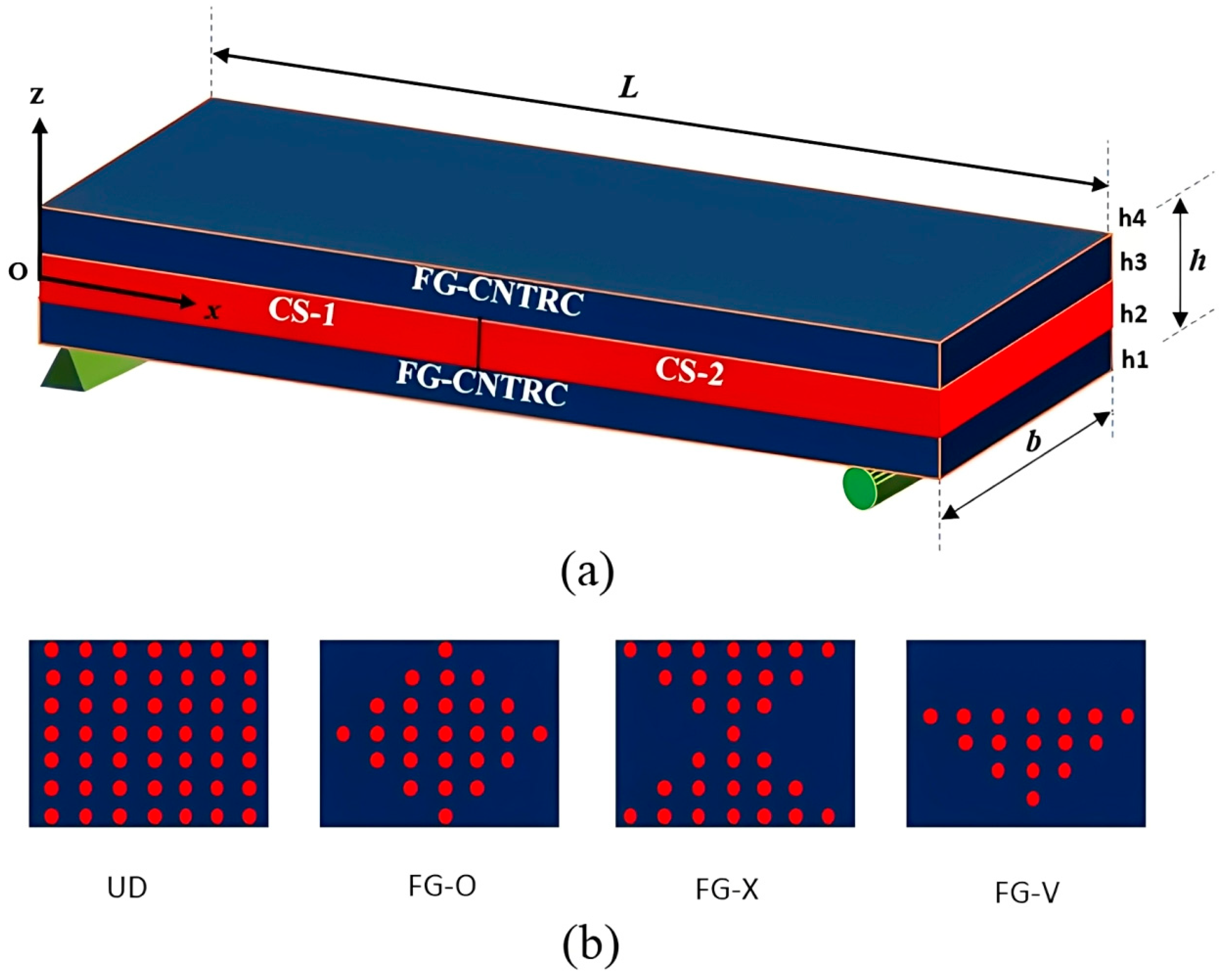


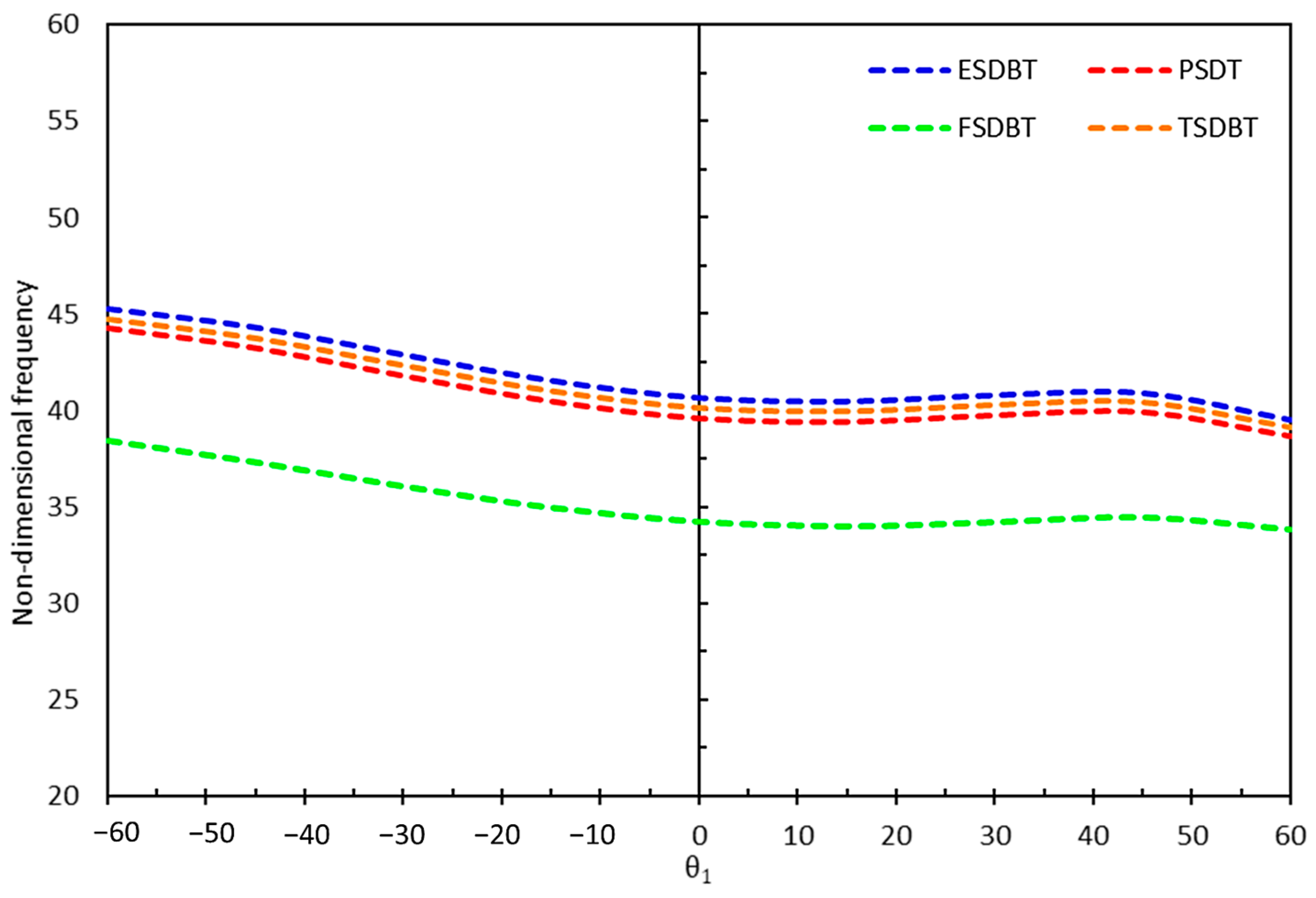
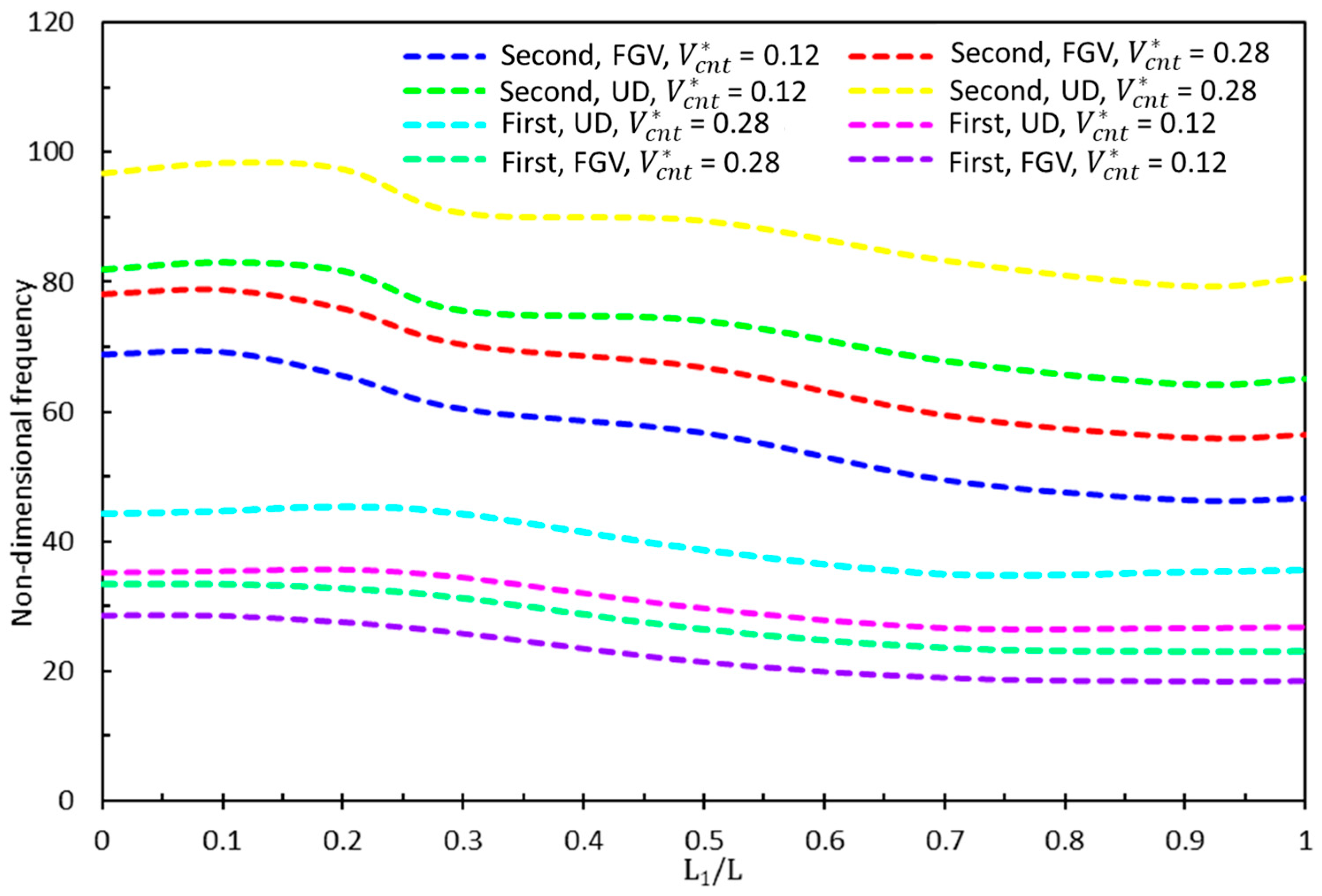
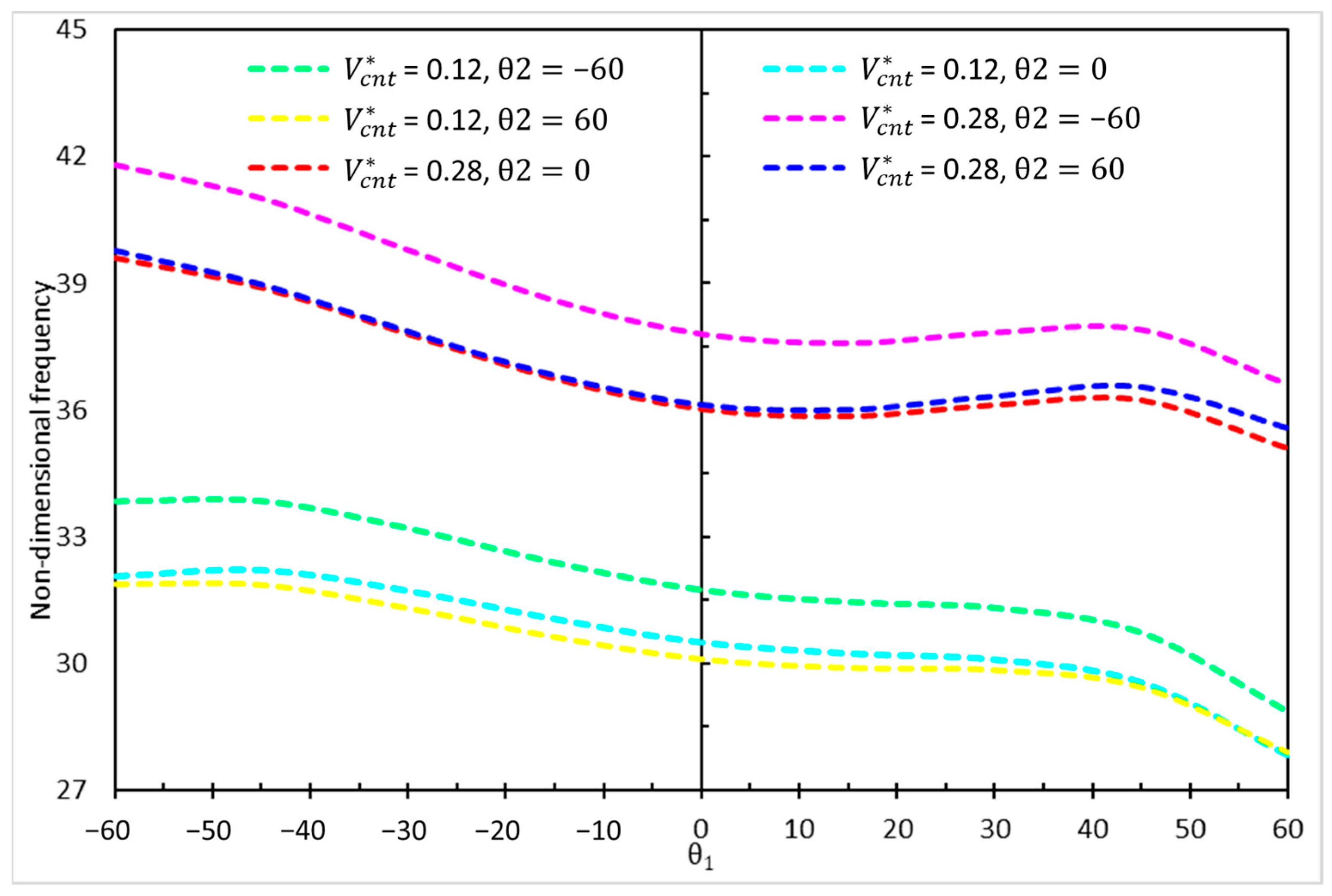
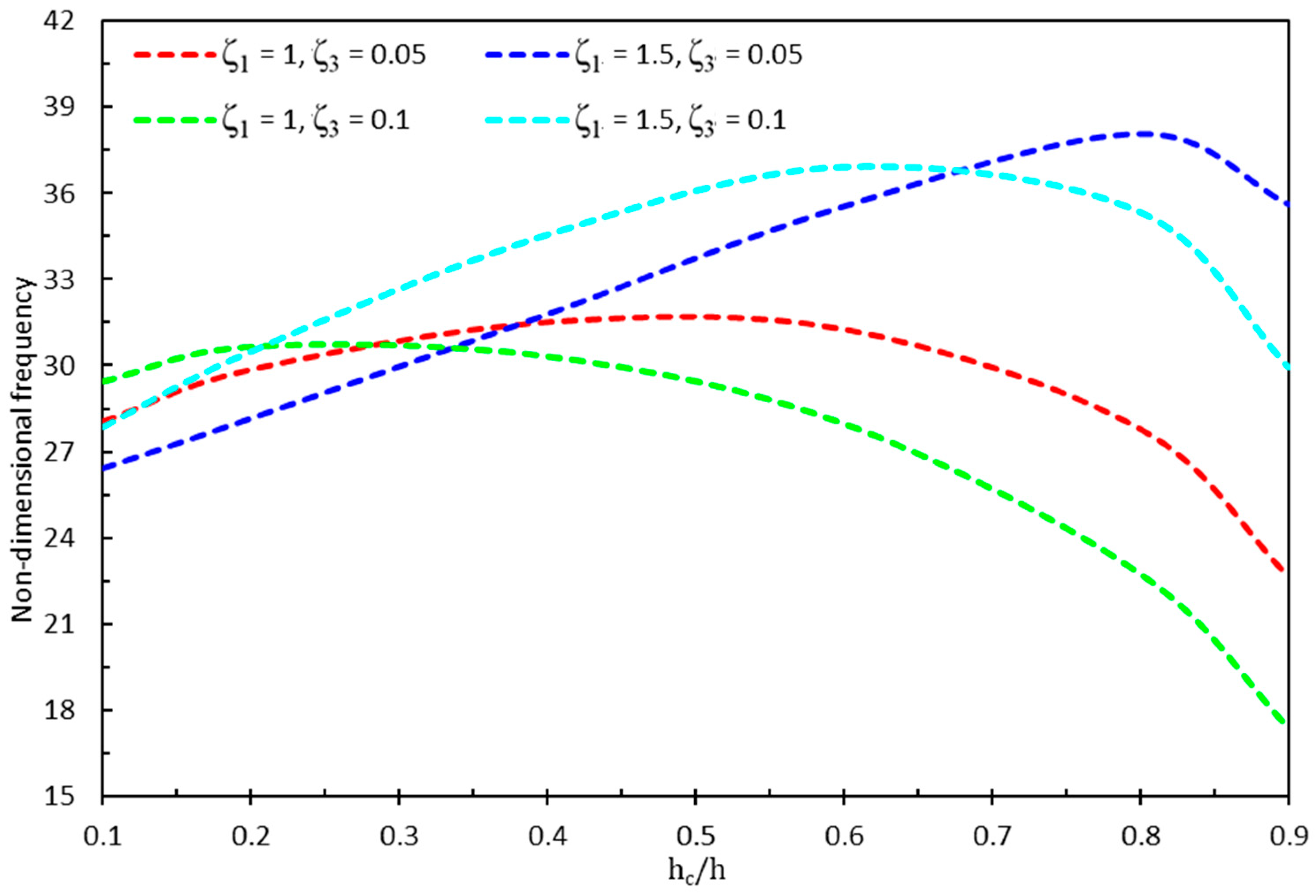

| Theory | g(z) | f(z) |
|---|---|---|
| FSDBT [26] | z | z |
| PSDBT [27] | z | |
| TSDBT [28] | z | |
| ESDBT [29] | z |
| FG-CNTRC | Present Study | Wu et al. [36] | ||||
|---|---|---|---|---|---|---|
| UD | 1.1074 | 1.3748 | 1.5920 | 1.0706 | 1.3325 | 1.5322 |
| FGO | 0.9014 | 1.1042 | 1.3228 | 0.8821 | 1.0834 | 1.2911 |
| FGX | 1.2233 | 1.5335 | 1.7668 | 1.1733 | 1.4750 | 1.6887 |
Disclaimer/Publisher’s Note: The statements, opinions and data contained in all publications are solely those of the individual author(s) and contributor(s) and not of MDPI and/or the editor(s). MDPI and/or the editor(s) disclaim responsibility for any injury to people or property resulting from any ideas, methods, instructions or products referred to in the content. |
© 2025 by the authors. Licensee MDPI, Basel, Switzerland. This article is an open access article distributed under the terms and conditions of the Creative Commons Attribution (CC BY) license (https://creativecommons.org/licenses/by/4.0/).
Share and Cite
Khoshgoftar, M.J.; Mehdianfar, P.; Shabani, Y.; Shaban, M.; Kalhori, H. Vibration Characteristics of Carbon Nanotube-Reinforced Sandwich Nanobeams with Hybrid Cellular Core. Vibration 2025, 8, 14. https://doi.org/10.3390/vibration8020014
Khoshgoftar MJ, Mehdianfar P, Shabani Y, Shaban M, Kalhori H. Vibration Characteristics of Carbon Nanotube-Reinforced Sandwich Nanobeams with Hybrid Cellular Core. Vibration. 2025; 8(2):14. https://doi.org/10.3390/vibration8020014
Chicago/Turabian StyleKhoshgoftar, Mohammad Javad, Pejman Mehdianfar, Yasin Shabani, Mahdi Shaban, and Hamed Kalhori. 2025. "Vibration Characteristics of Carbon Nanotube-Reinforced Sandwich Nanobeams with Hybrid Cellular Core" Vibration 8, no. 2: 14. https://doi.org/10.3390/vibration8020014
APA StyleKhoshgoftar, M. J., Mehdianfar, P., Shabani, Y., Shaban, M., & Kalhori, H. (2025). Vibration Characteristics of Carbon Nanotube-Reinforced Sandwich Nanobeams with Hybrid Cellular Core. Vibration, 8(2), 14. https://doi.org/10.3390/vibration8020014






